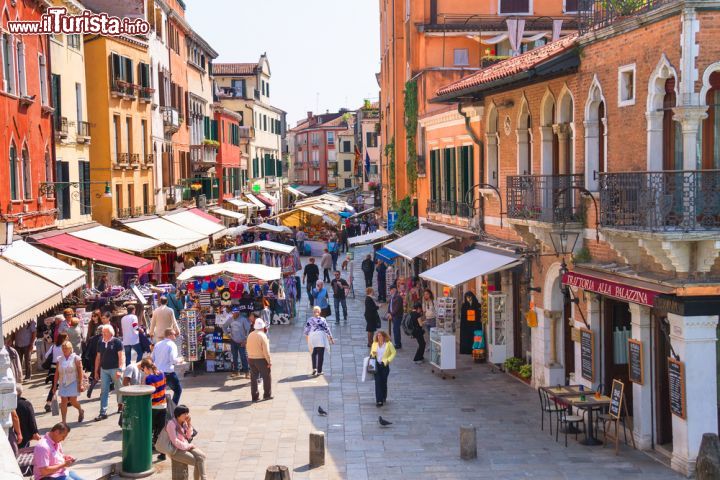 North of Piazza
North of Piazza
The main artery of the city, Haberdashery, a chain of rich looking streets, where all Venetian shopkeepers would like to place their shops, it most directly connects St.. Marka with the Rialto district (it starts under the clock tower, and ends at Campo San Bartolomeo). The only interesting point on this route, not counting shop windows, is erected at the beginning of. Church of San Salvatore on the original plan of three consecutive Greek crosses in the 16th century. It has two paintings by Titian: Transformation (1560; on the altar) and the Annunciation (1566). The clumsily painted angel on the latter is usually attributed to the clumsiness of the artist's assistants. At the end of the south transept is Caterina Comaro's tomb, who was for a time the Queen of Cyprus, until she was forced to surrender the island of Venice.
Campo San Bartolomeo looks most impressive in the evening, when it's crowded to the limit. Willing to get to know the character of the Venetians better, it is worth a moment at the monument sculpted by Goldoni, approx. time. 19.00. When the pressure starts to get too tight, you can switch to another, albeit a not so popular social center, nearby Campo San Luca.
Behind Campo San Luca is Campo Manin, on the south side of which there is a signpost to a masterpiece of architecture from the beginning of the. XVI century, the famous spiral staircase of Scala del Bovolo (bovolo means "snail shell" in the Venetian dialect). The Museo Fortuny is also nearby (wt.-nd. 9.00-19.00; 5000L), which is situated in such a place, that you would never get there by accident, but fortunately the access is marked with a small one, posters placed at eye level. The museum is dedicated to Marian Fortuny (1871-1949), who was not only the designer of the famous silk costumes (so delicate, that they could be threaded through the wedding ring), but also a painter, architect, engraver, photographer, a stage designer and sculptor. This versatility is reflected in the museum, and after leaving you regret it, that the museum does not yet have large collections.
West of Piazza
The area west of St.. The brand is less frequented, than the district north of him, although there are also quite a few fashionable shops here, e.g.. on Calle Larga XXII March, where there are many expensive fashion shops, jewelery, furniture or carpets. There are no important monuments in this area, but on the route from St.. Marek, through many dissimilar squares to the Accademia Bridge, There are also interesting objects.
Just west of Piazza stands the terrifyingly ugly Church of San Moise (codz. 15.30-19.00), who would have easily won the competition for the most ugly church building in Venice. Sculptures on the facade, among which the species of camel, unknown in zoology, stands out, were made in the year 1668 by Heinrich Meyring. There, who like the facade, they should see the altar of the same 'artist”, with the scene, on which Moses receives tablets on Mount Sinai.
Halfway down Calle Larga XXII, the margin diverges to the side of Calle del Sartor da Veste, which leads across the canal to Campo San Fantin. The Renaissance church of San Fantin with its beautiful rises here, topped with a dome apse designed by Sansovino. On the opposite side of the square is the largest and oldest (opened in December 1792 year) theater in venice, The Phoenix. I'm lucky, you can hit the day, when the audience, beautifully decorated with plush, is open to the public, gilding and stucco, rebuilt after a fire in the year 1836. The neighborhood of the opera house makes, that this district has some of the most expensive restaurants and fanciest boutiques in the city.
Returning to the Accademia tour, we encounter another, very strange church, Santa Maria Zobenigo (lub of the lily). You can look at its facade for a long time and you will not find any Christian symbol on it. The characters represent the five Barbaro brothers, who financed the reconstruction of the church in 1678 year. Above them "hover" allegories of Virtue, Honor, Fame and Wisdom, while the reliefs below show the maps of the cities, which the brothers have honored with their presence during their illustrious diplomatic and military careers.
On the next square, over the rather uninteresting church of San Maurizio, the leaning bell tower of the Church of Santo Stefano is visible, which stands at the corner of the next square, Campo Francesco Morosini (or Santo Stefano). This huge square could be crowded with tourists and children playing football at the same time, and it would still not be crowded, but only a pleasant animation. One of the best ice cream factories in the city is located in the square, Pauline. Located on the opposite side of the Campo Sant'Angelo Church (or Anzolo) it is almost as spacious and is surrounded by beautiful palaces, but the atmosphere is more like a crossroads, than a meeting place for local residents.
Among these non-Venetians, for whom the name Morosini evokes some associations, he is known as this, which, after Venice conquered the Peloponnese and Athens at the end of the 17th century, fired a missile through the roof of the Parthenon and caused the ammunition stored there to explode. He lived at the end of the square adjacent to the Grand Canal (no 2802), and is buried in Santo Stefano. This 13th century church was rebuilt in the 14th century, and then in the middle of. XV. Its gothic door arches and the ship's keel-shaped roof were created during this last phase of reconstruction. The best paintings in the church, Tintoretto's late work, Prayer in the Garden of Gethsemane, Last Supper and Washing the Feet of Students, are in the sacristy.